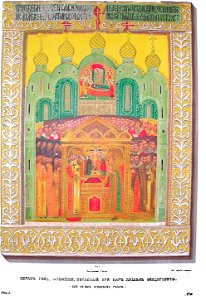The image of the deposition of the robe, painted during the reign of tsar mikhail fyodorovich (kept in the assumption cathedral in moscow) similar in style to the capponian calendar and to the icons painted in the 17th century by the stroganov society of zografs, this image is also remarkable for its content. The persian shah abbas, as a proof of his friendly disposition towards tsar mikhail fyodorovich, sent him, among other gifts, with the georgian urusambek, on march 11, 1625, a part of the lord's robe in a golden ark decorated with precious stones. In his letter, the shah reported that after the conquest of georgia, he found this relic in the metropolitan's sacristy. Although patriarch philaret accepted this sacred treasure with joy, since it came from an unfaithful tsar, he consulted with his sovereign son about whether the word of the infidels could be accepted without true testimony. Then philaret, with the consecrated council, began to examine it. In the ark was found, as stated in the circular charter, "a part of a robe, a span long and wide, of linen, if reddish, like chalk, or will have changed its appearance in olden times, and woven of flax. " at that time, patriarch theophanes of jerusalem, who appointed philaret as patriarch, was in moscow, and with him the greek elders nectarius and ioanniky. The moscow primate addressed them with questions about the lord's robe. Nectarius replied that he himself had seen this holy relic in georgia in a church called ileta, and had heard from the clergy there that it had once been brought there by a soldier who had been in jerusalem during the crucifixion of jesus christ, and had been marked by many miracles. Nectarius' words were confirmed by ioannikius, and other inhabitants of the east confirmed the truth of the traditions of the palestinian and greek christians about the lord's robe. The prudent philaret did not stop at human testimony, no matter how reliable it seemed, but used a spiritual means. After consultation with the bishops and spiritual authorities, a seven-day fast and prayer service were established, and in order to learn the will of god and to reveal the truth, it was ordered that this holy relic be placed on the sick and infirm. Many miracles justified the authenticity of the relic and the faith of those who accepted it. After that, the lord's robe was solemnly placed in the great dormition cathedral and an annual feast of the deposition of the lord's robe was established, which is still celebrated on july 10. On september 30, 7133, the patriarch built a majestic copper tent to house the relic, which occupies a place near the tomb of philaret in the southwest corner of the cathedral. On an image, apparently contemporary with the event, the tsar with three saints is seen inside this tent, standing in prayer before the throne on which the honorable and all-healing robe of the lord is placed. The tent is surrounded by spiritual authorities, monks, boyars and the people. In the foreground, mikhail fyodorovich, who was then 20 years old, is depicted beardless, in all the royal utensils; on the other side is the patriarch, probably of jerusalem, and behind him is the moscow patriarch and a bishop in mitres. The five-domed cathedral, where all this action takes place, is shown in section. In the arrangement or composition of the faces, symmetry is noticeable, so that in the foreground the figures are brighter and more prominent, but, due to a lack of knowledge of perspective, the faces in the second and third planes are of the same size as in the first. However, they do not have that uniformity that we find in many old icons; for the turns of the heads and faces are varied. For domestic archeology, the pre-personal, or the costumes of the ecclesiastical authorities, the monks, the laity of different classes - men and women - are important. In general and in parts, decorum is strictly observed, so that if there is no elegance in this image, there is no ugliness either. The coloring, if coloring can be called coloring, is distinguished by firmness, brightness, bonyness in high places and a fluidity, which, in all fairness, surprises foreign artists in the capponian calendar, where we meet the names of the royal icon painters in moscow in the 17th century. Unfortunately, we do not know the name of the zographer who painted this icon, memorable in historical, archaeological and artistic terms, but when comparing it with the works of the royal and patriarchal icon painters who formed the academy of arts at the courts of the sovereign and the saint, we can confidently conclude that it is their work. A large copy of this icon is among the local icons of the assumption cathedral of the trinity lavra of st. Sergius. Date: 1846—1853.
Loading...
